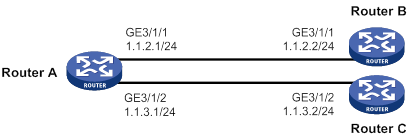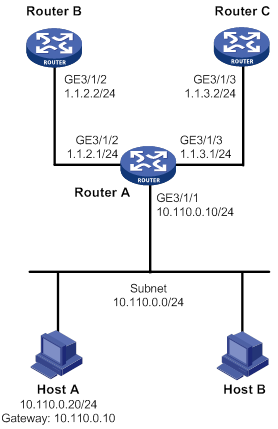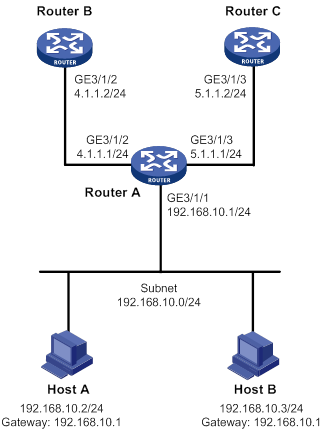- Table of Contents
-
- 07-Layer 3 - IP Routing Configuration Guide
- 00-Preface
- 01-Basic IP routing configuration
- 02-Static routing configuration
- 03-RIP configuration
- 04-OSPF configuration
- 05-IS-IS configuration
- 06-EIGRP configuration
- 07-BGP configuration
- 08-Policy-based routing configuration
- 09-IPv6 static routing configuration
- 10-RIPng configuration
- 11-OSPFv3 configuration
- 12-IPv6 policy-based routing configuration
- 13-Routing policy configuration
- 14-DCN configuration
- Related Documents
-
| Title | Size | Download |
|---|---|---|
| 08-Policy-based routing configuration | 129.82 KB |
Contents
Restrictions and guidelines: PBR configuration
Setting match criteria for a node
Configuring actions for a node
Specifying a policy for local PBR
Specifying a policy for interface PBR
Enabling the PBR logging feature
Display and maintenance commands for PBR
Example: Configuring packet type-based local PBR
Configuring PBR
About PBR
Policy-based routing (PBR) uses user-defined policies to route packets. A policy can specify parameters for packets that match specific criteria such as ACLs. The parameters include the next hop, output interface, and default next hop.
Packet forwarding process
The device forwards received packets using the following process:
1. The device uses PBR to forward matching packets.
2. If one of the following events occurs, the device searches for a route (except the default route) in the routing table to forward packets:
¡ The packets do not match the PBR policy.
¡ The PBR-based forwarding fails.
3. If the routing table-based forwarding fails, the device uses the default next hop defined in PBR to forward packets.
4. If the default next hop-based forwarding fails, the device uses the default route to forward packets.
PBR types
PBR includes the following types:
· Local PBR—Guides the forwarding of locally generated packets, such as ICMP packets generated by using the ping command.
· Interface PBR—Guides the forwarding of packets received on an interface.
Policy
A policy includes match criteria and actions to be taken on the matching packets. A policy can have one or multiple nodes as follows:
· Each node is identified by a node number. A smaller node number has a higher priority.
· A node contains if-match and apply clauses. An if-match clause specifies a match criterion, and an apply clause specifies an action.
· A node has a match mode of permit or deny.
A policy compares packets with nodes in priority order. If a packet matches the criteria on a node, it is processed by the action on the node. If the packet does not match any criteria on the node, it goes to the next node for a match. If the packet does not match the criteria on any node, the device performs a routing table lookup.
Relationship between if-match clauses
PBR supports only the if-match acl clause to set an ACL match criterion. On a node, you can specify only one if-match clause.
Relationship between apply clauses
You can specify multiple apply clauses for a node, but some of them might not be executed. For more information about relationship between apply clauses, see "Configuring actions for a node."
Relationship between the match mode and clauses on the node
|
Does a packet match all the if-match clauses on the node? |
Match mode |
|
|
Permit |
Deny |
|
|
Yes. |
· If the node contains apply clauses, PBR executes the apply clauses on the node and does not compare the packet with the next node. · If the node does not contain apply clauses, the device performs a routing table lookup for the packet. |
The device performs a routing table lookup for the packet. |
|
No. |
PBR compares the packet with the next node. |
PBR compares the packet with the next node. |
|
|
NOTE: A node that has no if-match clauses matches any packet. |
PBR and Track
PBR can work with the Track feature to dynamically adapt the availability status of an apply clause to the link status of a tracked object. The tracked object can be a next hop, output interface, or default next hop.
· When the track entry associated with an object changes to Negative, the apply clause is invalid.
· When the track entry changes to Positive or NotReady, the apply clause is valid.
For more information about Track-PBR collaboration, see High Availability Configuration Guide.
Restrictions and guidelines: PBR configuration
If a packet destined for the local device matches a PBR policy, PBR will execute the apply clauses in the policy, including the clause for forwarding. When you configure a PBR policy, be careful to avoid this situation.
PBR tasks at a glance
To configure PBR, perform the following tasks:
b. Setting match criteria for a node
c. Configuring actions for a node
2. Specifying a policy for PBR
Choose the following tasks as needed:
¡ Specifying a policy for local PBR
¡ Specifying a policy for interface PBR
3. (Optional.) Enabling the PBR logging feature
Configuring a policy
Creating a node
1. Enter system view.
system-view
2. Create a node for a policy, and enter its view.
policy-based-route policy-name [ deny | permit ] node node-number
Setting match criteria for a node
1. Enter system view.
system-view
2. Enter policy node view.
policy-based-route policy-name [ deny | permit ] node node-number
3. Set an ACL match criterion.
if-match acl { acl-number | name acl-name }
By default, no ACL match criterion is set.
The ACL match criterion cannot match Layer 2 information.
Configuring actions for a node
About apply clauses
The following apply clauses determine the packet forwarding paths in a descending order:
· apply access-vpn vpn-instance
· apply next-hop
· apply output-interface
· apply default-next-hop
PBR supports the types of apply clauses shown in Table 1.
Table 1 Priorities and meanings of apply clauses
|
Clause |
Meaning |
Priority |
|
apply precedence |
Sets an IP precedence. |
This clause is always executed. |
|
apply access-vpn vpn-instance |
Sets VPN instances. |
If a packet matches a forwarding entry of a specified VPN instance, it is forwarded in the VPN instance. This clause is not supported on SPC or MPE-1104 cards. |
|
apply next-hop and apply output-interface |
Sets next hops and sets output interfaces. |
If both clauses are configured, only the apply next-hop clause is executed. The apply output-interface clause is not supported on SPC or MPE-1104 cards. |
|
apply default-next-hop |
Sets default next hops. |
The clause takes effect only in the following cases: · No next hop is set or the next hop is invalid. · The packet does not match any route in the routing table. These clauses are not supported on SPC or MPE-1104 cards. |
Restrictions and guidelines
For outbound PBR, you can specify only one next hop and the next hop must be directly connected.
If you specify a next hop or default next hop, PBR periodically performs a lookup in the FIB table to determine its availability. Temporary service interruption might occur if PBR does not update the route immediately after its availability status changes.
Configuring actions to modify packet fields
1. Enter system view.
system-view
2. Enter policy node view.
policy-based-route policy-name [ deny | permit ] node node-number
3. Set an IP precedence.
apply precedence { type | value }
By default, no IP precedence is specified.
Configuring actions to direct packet forwarding
1. Enter system view.
system-view
2. Enter policy node view.
policy-based-route policy-name [ deny | permit ] node node-number
3. Configure actions.
¡ Set VPN instances.
apply access-vpn vpn-instance vpn-instance-name
This command is not supported on SPC or MPE-1104 cards.
By default, no VPN instances are specified.
¡ Set next hops.
apply next-hop [ vpn-instance vpn-instance-name ] { ip-address [ direct ] [ track track-entry-number ] }&<1-2>
By default, no next hops are specified.
You can specify multiple next hops for backup or load sharing in one command line or by executing this command multiple times.
¡ Set output interfaces.
apply output-interface { interface-type interface-number [ track track-entry-number ] }
This command is not supported on SPC or MPE-1104 cards.
By default, no output interfaces are specified.
¡ Set default next hops.
apply default-next-hop [ vpn-instance vpn-instance-name ] { ip-address [ direct ] [ track track-entry-number ] }&<1-2>
This command is not supported on SPC or MPE-1104 cards.
By default, no default next hops are specified.
You can specify multiple default next hops for backup or load sharing in one command line or by executing this command multiple times.
Specifying a policy for PBR
Specifying a policy for local PBR
About local PBR
Perform this task to specify a policy for local PBR to guide the forwarding of locally generated packets.
Restrictions and guidelines
You can specify only one policy for local PBR and must make sure the specified policy already exists. Before you apply a new policy, you must first remove the current policy.
Local PBR might affect local services such as ping and Telnet. When you use local PBR, make sure you fully understand its impact on local services of the device.
Procedure
1. Enter system view.
system-view
2. Specify a policy for local PBR.
ip local policy-based-route policy-name
By default, local PBR is not enabled.
Specifying a policy for interface PBR
About interface PBR
Perform this task to apply a policy to an interface to guide the forwarding of packets received on the interface.
Restrictions and guidelines
You can apply only one policy to an interface and must make sure the specified policy already exists. Before you can apply a new interface PBR policy to an interface, you must first remove the current policy from the interface.
You can apply a policy to multiple interfaces.
Procedure
1. Enter system view.
system-view
2. Enter interface view.
interface interface-type interface-number
3. Specify a policy for interface PBR.
ip policy-based-route policy-name [ share-mode ]
By default, no interface policy is applied to an interface.
Enabling the PBR logging feature
About the PBR logging feature
The PBR logging feature helps the administrator locate and fix faults. The feature logs PBR events and sends the logs to the information center. The information center processes the logs according to output rules. For more information about the information center, see Network Management and Monitoring Configuration Guide.
Procedure
1. Enter system view.
system-view
2. Enable the PBR logging feature.
ip policy-based-route-log enable
By default, the PBR logging feature is disabled.
Display and maintenance commands for PBR
Execute display commands in any view and reset commands in user view.
|
Task |
Command |
|
Display PBR policy information. |
display ip policy-based-route [ policy policy-name ] |
|
Display PBR configuration. |
display ip policy-based-route setup |
|
(In standalone mode.) Display local PBR configuration and statistics. |
display ip policy-based-route local [ slot slot-number ] |
|
(In IRF mode.) Display local PBR configuration and statistics. |
display ip policy-based-route local [ chassis chassis-number slot slot-number ] |
|
(In standalone mode.) Display interface PBR configuration and statistics. |
display ip policy-based-route interface interface-type interface-number [ slot slot-number ] |
|
(In IRF mode.) Display interface PBR configuration and statistics. |
display ip policy-based-route interface interface-type interface-number [ chassis chassis-number slot slot-number ] |
|
Clear PBR statistics. |
reset ip policy-based-route statistics [ policy policy-name ] |
PBR configuration examples
Example: Configuring packet type-based local PBR
Network configuration
As shown in Figure 1, Router B and Router C do not have a route to reach each other.
Configure PBR on Router A to forward all TCP packets to the next hop 1.1.2.2 (Router B).

Procedure
1. Configure Router A:
# Configure the IP addresses of GigabitEthernet 3/1/1 and GigabitEthernet 3/1/2.
<RouterA> system-view
[RouterA] interface gigabitethernet 3/1/1
[RouterA-GigabitEthernet3/1/1] ip address 1.1.2.1 24
[RouterA-GigabitEthernet3/1/1] quit
[RouterA] interface gigabitethernet 3/1/2
[RouterA-GigabitEthernet3/1/2] ip address 1.1.3.1 24
[RouterA-GigabitEthernet3/1/2] quit
# Configure ACL 3101 to match TCP packets.
[RouterA] acl advanced 3101
[RouterA-acl-ipv4-adv-3101] rule permit tcp
[RouterA-acl-ipv4-adv-3101] quit
# Configure Node 5 for the policy aaa to forward TCP packets to next hop 1.1.2.2.
[RouterA] policy-based-route aaa permit node 5
[RouterA-pbr-aaa-5] if-match acl 3101
[RouterA-pbr-aaa-5] apply next-hop 1.1.2.2
[RouterA-pbr-aaa-5] quit
# Configure local PBR by applying the policy aaa to Router A.
[RouterA] ip local policy-based-route aaa
2. On Router B, configure the IP address of GigabitEthernet 3/1/1.
<RouterB> system-view
[RouterB] interface gigabitethernet 3/1/1
[RouterB-GigabitEthernet3/1/1] ip address 1.1.2.2 24
3. On Router C, configure the IP address of GigabitEthernet 3/1/2.
<RouterC> system-view
[RouterC] interface gigabitethernet 3/1/2
[RouterC-GigabitEthernet3/1/2] ip address 1.1.3.2 24
Verifying the configuration
1. Perform telnet operations to verify that local PBR on Router A operates as configured to forward the matching TCP packets to the next hop 1.1.2.2 (Router B), as follows:
# Verify that you can telnet to Router B from Router A successfully. (Details not shown.)
# Verify that you cannot telnet to Router C from Router A. (Details not shown.)
2. Verify that Router A forwards packets other than TCP packets through GigabitEthernet 3/1/2. For example, verify that you can ping Router C from Router A. (Details not shown.)
Example: Configuring packet type-based interface PBR
Network configuration
As shown in Figure 2, Router B and Router C do not have a route to reach each other.
Configure PBR on Router A to forward all TCP packets received on GigabitEthernet 3/1/1 to the next hop 1.1.2.2 (Router B).

Procedure
1. Make sure Router B and Router C can reach Host A. (Details not shown.)
2. Configure Router A:
# Configure the IP addresses of GigabitEthernet 3/1/2 and GigabitEthernet 3/1/3.
<RouterA> system-view
[RouterA] interface gigabitethernet 3/1/2
[RouterA-GigabitEthernet3/1/2] ip address 1.1.2.1 24
[RouterA-GigabitEthernet3/1/2] quit
[RouterA] interface gigabitethernet 3/1/3
[RouterA-GigabitEthernet3/1/3] ip address 1.1.3.1 24
[RouterA-GigabitEthernet3/1/3] quit
# Configure ACL 3101 to match TCP packets.
[RouterA] acl advanced 3101
[RouterA-acl-ipv4-adv-3101] rule permit tcp
[RouterA-acl-ipv4-adv-3101] quit
# Configure Node 5 for the policy aaa to forward TCP packets to next hop 1.1.2.2.
[RouterA] policy-based-route aaa permit node 5
[RouterA-pbr-aaa-5] if-match acl 3101
[RouterA-pbr-aaa-5] apply next-hop 1.1.2.2
[RouterA-pbr-aaa-5] quit
# Configure interface PBR by applying the policy aaa to GigabitEthernet 3/1/1.
[RouterA] interface gigabitethernet 3/1/1
[RouterA-GigabitEthernet3/1/1] ip address 10.110.0.10 24
[RouterA-GigabitEthernet3/1/1] ip policy-based-route aaa
[RouterA-GigabitEthernet3/1/1] quit
Verifying the configuration
1. Perform telnet operations to verify that interface PBR on Router A operates as configured to forward the matching TCP packets to the next hop 1.1.2.2 (Router B), as follows:
# Verify that you can telnet to Router B from Host A successfully. (Details not shown.)
# Verify that you cannot telnet to Router C from Host A. (Details not shown.)
2. Verify that Router A forwards packets other than TCP packets through GigabitEthernet 3/1/3. For example, verify that you can ping Router C from Host A. (Details not shown.)
Example: Configuring source-IP-based interface PBR
Network configuration
As shown in Figure 3, Router B and Router C do not have a route to reach each other.
Configure interface PBR to guide the forwarding of packets received on GigabitEthernet 3/1/1 of Router A as follows:
· Set the next hop of packets sourced from 192.168.10.2 to 4.1.1.2/24.
· Set the next hop of other packets to 5.1.1.2/24.

Procedure
1. Make sure Router B can reach Host A and Host B, and Router C can reach Host A and Host B. (Details not shown.)
2. Configure Router A:
# Configure the IP addresses of GigabitEthernet 3/1/2 and GigabitEthernet 3/1/3.
<RouterA> system-view
[RouterA] interface gigabitethernet 3/1/2
[RouterA-GigabitEthernet3/1/2] ip address 4.1.1.1 24
[RouterA-GigabitEthernet3/1/2] quit
[RouterA] interface gigabitethernet 3/1/3
[RouterA-GigabitEthernet3/1/3] ip address 5.1.1.1 24
[RouterA-GigabitEthernet3/1/3] quit
# Configure ACL 2000 to match packets sourced from 192.168.10.2.
[RouterA] acl basic 2000
[RouterA-acl-ipv4-basic-2000] rule 10 permit source 192.168.10.2 0
[RouterA-acl-ipv4-basic-2000] quit
# Configure Node 0 for the policy aaa to forward packets sourced from 192.168.10.2 to next hop 4.1.1.2. Configure Node 1 for the policy aaa to forward other packets to next hop 5.1.1.2.
[RouterA] policy-based-route aaa permit node 0
[RouterA-pbr-aaa-0] if-match acl 2000
[RouterA-pbr-aaa-0] apply next-hop 4.1.1.2
[RouterA-pbr-aaa-0] quit
[RouterA] policy-based-route aaa permit node 1
[RouterA-pbr-aaa-1] apply next-hop 5.1.1.2
[RouterA-pbr-aaa-1] quit
# Configure interface PBR by applying the policy aaa to GigabitEthernet 3/1/1.
[RouterA] interface gigabitethernet 3/1/1
[RouterA-GigabitEthernet3/1/1] ip address 192.168.10.1 24
[RouterA-GigabitEthernet3/1/1] ip policy-based-route aaa
[RouterA-GigabitEthernet3/1/1] quit
Verifying the configuration
1. Verify that interface PBR on Router A operates as configured to forward packets sourced from 192.168.10.2 to the next hop 4.1.1.2 and packets sourced from 192.168.10.3 to the next hop 5.1.1.2:
# Configure IP address 192.168.10.3/24 for Host B, and specify its gateway address as 192.168.10.1. (Details not shown.)
# Verify that you can ping Router B from Host A. (Details not shown.)
# Verify that you can ping Router C from Host B. (Details not shown.)
# Verify that you cannot ping Router B from Host B. (Details not shown.)
# Verify that you cannot ping Router C from Host A. (Details not shown.)

